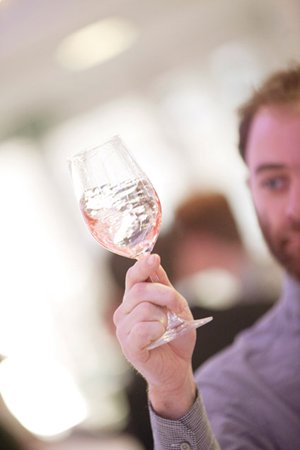Sparkling Wine & Champagne: Rosé
A really healthy category, with many entries, surprisingly high quality and genuinely good Gold medal winners in a variety of styles
Perhaps not surprisingly, since all things pink and all things fizzy are super-hot at the moment, the category that combines both these things – pink fizz – saw a big increase in entries this year, with more than twice as many wines as last year.
In fact, from having been something of a pink fizzy weakling five years ago, it is now a toned, muscular beefcake, with a lot of entries, beautifully (and evenly) spread from £6 up to £40.
 Within this, of course, there were regional hot-spots. Under £10 it was all cava, NE Italians and the occasional Saumur. The UK bottles huddled like rain-lashed starlings between £15 and £25, while the Champagnes finally breezed in around the £20 level.
Within this, of course, there were regional hot-spots. Under £10 it was all cava, NE Italians and the occasional Saumur. The UK bottles huddled like rain-lashed starlings between £15 and £25, while the Champagnes finally breezed in around the £20 level.
If there was one surprise about the make-up of the contenders, it was (as with white fizz) the paucity of entries from the New World. While the Aussies, Kiwis et al could claim that their winemakers are still coming to terms with the tricksy nature of making sparkling rosé, the same excuse doesn’t hold for, say, the Loire, which, for all the two deserved Silvers and single Bronze, really should be doing more to stake a claim at the affordable end of things.
Amazingly, given how hard it is to make decent pink fizz, when it came to quality, this was one of the stronger parts of the competition. Unlike non-fizzy pinks (whether in the House Wine section or the Rosé category) the tasters found a good spread of really decent wines here. Last year there was a total of eight medals. This year, ze Ambassadeur was spoiling us, with five Golds, nine Silvers and eight Bronzes.
At the cheaper end of the scale, there were two main styles: slightly sweeter and fruitier, and drier and paler. And to their credit, the tasting teams didn’t shy away from the former, recognising that, much like wasps, there was a place for it in the grand scheme of things.
‘Some of them had too much residual sugar for me personally, but for a summer drink they were really good,’ said The Tate Group’s Gustavo Medina charitably.
Firmly in this category was the candyfloss pink Castillo Perelada Rosado at £6.66, which was seen as a great By the Glass glugger for pubs, functions and parties. The Italian Villa Sandi at £7.00 was a bit more of a foodie wine, but still really well priced.
‘I could definitely see a market for well-made pink fizz at country-house weddings, where people are not going to blow pink Champagne on 120 guests,’ said Chester Grosvenor’s Garry Clark.
Hearteningly, while this is unquestioningly a hot category, it didn’t seem to be an area where wineries were jumping on the bandwagon. As the prices moved upwards, quality went with it, which meant that this section of our Gold List covered both ‘cheap’ and ‘superlative’ with ease.
‘I think the people who made these wines made them for the right reasons – because they want to make a good wine, not simply because they need to make a wine of that colour,’ said China Tang’s Xavier Chapelou.
‘There was some good complexity and refined fruit here,’ agreed Hakkasan’s Serdar Balkaya. ‘I rated the more Old World, autolytic wines more highly. They’re the kinds of wines I would consider listing.’
If the star wine was the Perrier-Jouët Blason Rosé at just under £40, praised by River Café’s Emily O’Hare for having ‘really fine tailoring. It would be great in so many different scenarios’, Deutz deserves an honourable mention for following up its white NV Gold with a rosé here.
As the Sommelier Wine Awards grows, such achievements become ever harder.
Two further stories worth pointing out: the presence of two English Silvers, handily placed price-wise between New World and Champagne and the presence of the (non-off-trade-available) Jacob’s Creek Trilogy at £12.99, which was praised for being a ‘really good traditional-style fizz with red fruit and crisp, citrusy characters’.
‘It reminded me of strawberries and roses,’ mused Felicity Hall of Min Jiang at the Royal Garden Hotel. ‘It could be both an aperitif or served with salad and cured meats in the summer.’
‘The two most expensive golds were real food wines. I can see people wanting to have Champagne right through the meal, and these wines at the upper end would let you do that.’ Maria Rodriguez, consultant
‘For more traditional restaurants like us it’s still all about Champagne, value for money or not. It’s a special occasion drink and people don’t want to look cheap.’
Mariyana Radulova , Royal Thames Yacht Club